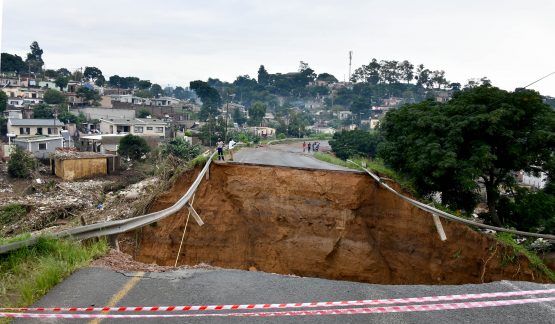Floods and car claims hit Santam

Short-term insurer Santam took a knock in 2020 when it faced unprecedented claims related to the Covid-19 pandemic, another knock in 2021 due to the social unrest and looting in KwaZulu-Natal, and then another in 2022 when the province was hit by catastrophic floods.
Recently, more floods and an increase in car theft (and costly road accidents) are keeping management on their toes.
Unfortunately, the higher incidence of natural disasters, higher crime levels, rising inflation and more vehicle accidents will result in an increase in insurance premiums and see clients paying a bigger excess when lodging a claim.
“The past financial year was one of the most challenging underwriting periods in Santam’s history,” says new chief executive Tavaziva Madzinga, who had to deal with all these problems when he took over halfway through the year.
Financially, Santam also had to cope with very volatile investment markets to safeguard its reserves.
“However, insurance companies are designed to do this,” says Madzinga. “We deal with problems and assist clients in times of need. Despite these challenges, we reported strong gross written premium growth and resilient net insurance results.”
Santam posted an increase of 6% in net insurance premiums to R28 billion in the year to end-December 2022 – and claims of R29.8 billion, with reinsurance partners contributing R11.1 billion to the latter.
Santam CFO Hennie Nel says reinsurance premiums increased after the KwaZulu-Natal flood claims, included a reinstatement fee, and became more expensive due to inflationary pressures.
Johan de Kock, portfolio manager and analyst at Vunani Fund Managers, says it is important to note that reinsurance payments and claims from reinsurance are not always aligned.
“Reinsurance premiums paid [are] forward-looking, while the recovery for reinsurance is backward-looking.
“It is possible that they have a mismatch between the year in which they pay reinsurance and pay claims, and then recover from reinsurance,” says De Kock, adding that large claims such as those related to the floods take time to assess, pay and recover due to their complexity.
Inflation
Higher inflation also plays havoc with the settling of claims, as the value of claims increases at a faster rate – due to higher replacement and repair costs – than Santam is able to increase its premiums.
However, premiums and excess payments had to be increased.
Santam also notes that it has seen a higher incidence of motor vehicle theft, despite motor manufacturers continuously improving their security systems.
“Criminals are getting more sophisticated too, using all kinds of tech to bypass security systems,” says Madzinga.
“Santam works closely with motor manufacturers to improve systems, as well as clients of high-end ‘desirable’ vehicles to fit better tracking devices.”
Repricing and reducing risks seems to have worked. The motor vehicle book showed a net underwriting surplus of R273 million in the second half of the financial year compared with R109 million in the first half.
Claims and margin
That Santam paid R29.8 billion in claims during the financial year to end December 2022 means that it paid out some R5.3 billion more than in 2021. It notes that the KwaZulu-Natal floods resulted in R4.4 billion worth of claims.
“The net underwriting margin was at the bottom end of the group’s target range of 5% to 10%,” says Madzinga.
“Adverse weather conditions in the first three months of the year and the devastating floods in the KwaZulu-Natal province during early April 2022, significantly impacted the underwriting results.
“Other contributing factors to the lower underwriting margin were increased claims inflation, which escalated ahead of premium increases; higher than expected large fire losses; and an increase in power surge and crime-related claims.
“These were offset to some extent by a reduction in the Covid-19-related contingent business interruption [CBI] claims provisions.”
It reduced its net provision for CBI claims by a further R317 million, following the reduction of R397 million brought to book in the first half of the financial year.
It says the reduction is mainly due to the actual claims being lower than initial estimates, but warns shareholders that “there remains some uncertainty about the ultimate liability, which will only be eliminated once the process has been finalised”.
Profitability remains a concern.
Return on capital of less than 19% was below the target of 24%, but a significant improvement on the 7.4% reported for the first six months of 2022.
Analysis
Vunani Fund Managers describes Santam’s results as “reasonable” given the very difficult operating environment.
“I think they delivered,” says De Kock.
He notes that inflation also played a part in reducing the underwriting margin from 8% to 5.1%.
“The KZN floods were one of the largest claims events for SA short-term insurers and we can expect them to be impacted,” he says, adding that reinsurance costs are increasing across the sector due to all the events that have increased its risk profile.
Madzinga says there has been a significant increase in reinsurance premium rates globally, following several large ‘catastrophe’ events globally and locally.
Outlook
Santam expects trading conditions to remain very competitive in 2023.
“High interest rates and significant inflationary pressures continue to decrease disposable income in SA. It is expected that economic activity will, in the short- to medium term, be constrained by weak consumer spending,” says Madzinga.
“The high inflation environment also puts pressure on claims costs, while the ongoing Eskom load shedding negatively impacts economic growth and results in increased power surge claims.
“Underwriting actions to address these matters, which include procurement efficiencies, premium increases and higher claim excesses, showed a positive impact during the second half of the year and are expected to continue into 2023.”

